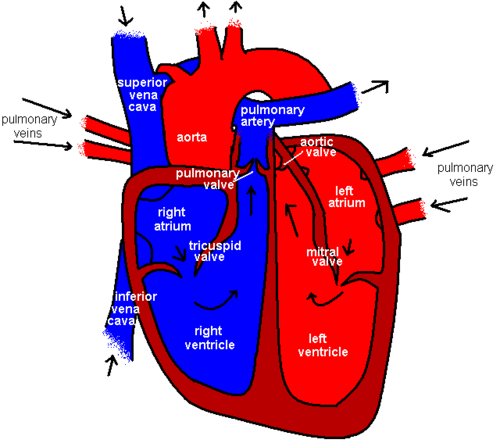Heart: Difference between revisions
| Line 87: | Line 87: | ||
==Clinical Conditions== | ==Clinical Conditions== | ||
6. Surface Markings | 6. Surface Markings | ||
Revision as of 12:19, 7 April 2008
Structure and Function
Structure
Function
The normal heart contracts at around 70-90bpm in the normal resting adult. This rhythm originates spontaneously in the conducting system, and then moves to the parts of the heart. There is a delay between the impulse reaching the ventricles from the atria in order to allow the atria to empty their blood into the ventricles before the ventricles contract.
- Sinoatrial node
- Located in the wall of the right atrium just to the right of the opening to the superior vena cava.
- This node gives a spontaneous impulse that spreads in all directions through the myocardium of the atria.
- This causes the atrial muscle to contract.
- Atrioventricular node
- Located on the lower part of the atrial septum, just above the tricuspid valve.
- Activated by the excitation wave that passes through the atria from the SAN.
- From this the impulse moves to the Atrioventricular bundle, where it moves on down through the ventricles.
- Atrioventricular bundle
- It is usually known as the Bundle of His
- It is the only pathway of cardiac muscle that connects the myocardium of the atria and the myocardium of the ventricles, so it's the only route the impulse can travel down
- It descends through the fibrous skeleton of the heart.
- At the bottom of the membranous part of the ventricular septum, just before the muscular part of the septum, it divides into two branches, one for each ventricle.
- The right bundle branch (RBB) travels down the right ventricle wall and joins the Purkinje fibres (a big web of conductive tissue)
- The left bundle branch (LBB) travels down the left ventricular wall, usually splits into anterior and posterior branches then joins the Purkinje fibres
- Purkinje fibres
- Lots of cross linking strands.
- Covers the whole ventricle wall.
- Ensures that the whole of each ventricle contracts at once to efficiently pump blood.
Arterial and Venous supply
Coronary Arteries
The left and right coronary arteries come off the aorta in the aortic sinus, the right one anteriorly, the left one posteriorly Three key points to learn:
- The left anterior descending (anterior interventricular) is the worst one to get blocked. If that happens you are probably dead.
- The coronary arteries anastomose (overlap and connect together) but not usually enough to provide collateral circulation if one of the main arteries does anastomose.
- Coronary arteries change and shift. Eg. In 10% of people the posterior interventricular actually comes off the circumflex, not the right. It's called left and right dominance. Do not be surprised to see random differences, nothing is set in stone.
What they supply:
- Right coronary artery
- Nearly all of the right ventricle.
- The whole right atrium and a little bit of the left atrium.
- The back third of the septum.
- The Sinoatrial and Atrioventricular nodes.
- A small amount of the LBB.
- Left coronary artery
- The whole left ventricle and a little bit of the right one.
- Nearly all of the left atrium.
- The front two thirds of the septum.
- The RBB and most of the LBB. `
Coronary veins
Most blood from the heart wall drains into the right atrium through the coronary sinus – this lies in the posterior atrioventricular groove. There are two main veins, the great cardiac vein (with the small and middle cardiac veins draining into it) and the anterior cardiac vein.
Nervous Supply
Innervated via the cardiac plexuses situated below the arch of the aorta
Sympathetic
Comes off the cervical and upper thoracic portions of the sympathetic trunks
- Positive inotrophic effect on myocardial muscles (they pump faster)
- Positive chronotrophic effect on the SAN (speeds it up)
- Dilatory effect on coronary arteries
Parasympathetic
Comes off the vagus nerves
- Negative inotrophic effect on myocardial muscle (pumps less hard)
- Negative chronotrophic effect on the SAN (goes slower)
- Constrictory (yes that's a word) on the coronary arteries.
Lymph
Does it have any? Probably not.
Histology
Endocardium
Specialised endothelial membrane, composed of a very thin and smooth squamous epithelium. It is this that forms the cusps (segments) of the valves.
Myocardium
Specialised cardiac muscle cells that unlike any other type of muscle, can conduct electricity. The myocardium is thicker in the ventricles than the atria. Cardiac muscle cells are striated with myofibrils which are alternating filaments of myosin and actin subunits. Joined by anchoring junctions, they are mononucleated, and shorter than skeletal muscle. The cells are interspersed with connective tissue.
Visceral Pericardium
(AKA Epicardium) It's closed sac of serous membrane (with mesothelium) that covers the outside of the heart and the coronary blood vessels.
Pericardial cavity
The gap between membranes, contains pericardial fluid for lubrication. ====Parietal Pericardium The other layer of (with mesothelium).
Fibrous Pericardium
Attached to large blood vessels leaving the heart.
Mediastinal pleura
The pleurae that surround the mediastinum.
Easy (Corny) way to remember:
Elephants Must Vacate Parking Places For Mice
Clinical Conditions
6. Surface Markings
Tricuspid: Right hand side of the sternum at the fourth intercostal space Mitral: Left hand side of the sternum at the fourth costal cartilage Aortic: Left hand side of the sternum at the third intercostal space Pulmonary: Medial end of the third costal cartilage
